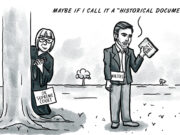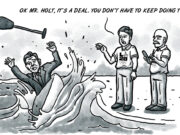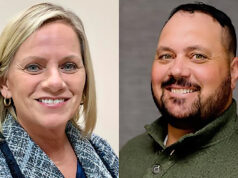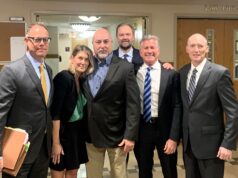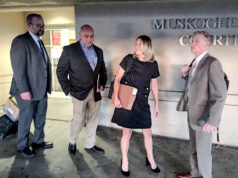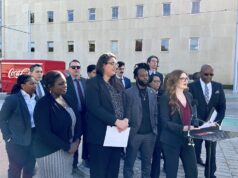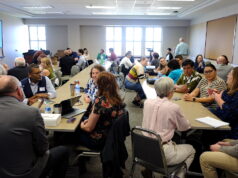
The American Society of News Editors has conducted a census of racial diversity in newsrooms every year since 1997. The stated goal of the annual study is to have “the percentage of minorities working in newsrooms nationwide equal to the percentage of minorities in the nation’s population by 2025.”
ASNE recently released its 2016 numbers, and the results show that, nationwide, “people of color make up about 17 percent of newsroom staffs.” In Oklahoma, participating newsrooms exhibit an average of 14.5 percent minorities on staff. (The Tulsa World, for instance, is not included in the data.)
The most recent U.S. Census data show that about three-fourths of Oklahoma’s population identifies as “white alone,” meaning there’s 25 percent of the state population identifying as a racial minority. In that context, newsrooms in the Sooner State have a long way to go before coming close to achieving ASNE’s diversity goal.
Disclaimer
I fully understand that some will read this article thinking, “NonDoc is three white people and a Bangladeshi; where do they get off discussing the diversity of other organizations?”
First, I would point out that the presence of Dr. Ashiq Zaman on our board gives us a 25 percent overall minority representation, which would put us in the top-five most diverse outfits in this list. Further, we regularly publish commentaries and other contributions from writers with a multitude of racial backgrounds, including people who live on the other side of the world.
But if you still think it’s hypocritical of me to lament the obvious whiteness of some of the state’s larger, well-funded and historical newspapers, then sure, call me a hypocrite. At the very least, perhaps this article will spark a conversation that the other Oklahoma news outlets seem unwilling to have.
2016 minority percentages at participating Oklahoma news organizations
As the title implies, the study includes only those organizations that chose to participate. Consequently, not all of the state’s newsrooms are included. What remains clear, however, is that diversity in Oklahoma’s newsrooms appears to be lacking compared to the national average.
| Publication | White | Black | Hispanic | Am. Ind. | Asian | Haw/Pac. Is | Other | Total Minority |
| Daily News & Sun (Poteau) | 100 | 0 | 0 | 0 | 0 | 0 | 0 | 0 |
| Examiner-Enterprise (Bartlesville) | 100 | 0 | 0 | 0 | 0 | 0 | 0 | 0 |
| Guthrie News Leader | 100 | 0 | 0 | 0 | 0 | 0 | 0 | 0 |
| Holdenville Daily News | 100 | 0 | 0 | 0 | 0 | 0 | 0 | 0 |
| Miami News-Record | 100 | 0 | 0 | 0 | 0 | 0 | 0 | 0 |
| Sapulpa Daily Herald | 100 | 0 | 0 | 0 | 0 | 0 | 0 | 0 |
| The Lawton Constitution | 100 | 0 | 0 | 0 | 0 | 0 | 0 | 0 |
| The Express-Star (Chickasha) | 100 | 0 | 0 | 0 | 0 | 0 | 0 | 0 |
| The Grove Sun Daily | 100 | 0 | 0 | 0 | 0 | 0 | 0 | 0 |
| The Perry Daily Journal | 100 | 0 | 0 | 0 | 0 | 0 | 0 | 0 |
| Vinita Daily Journal | 100 | 0 | 0 | 0 | 0 | 0 | 0 | 0 |
| Woodward News | 100 | 0 | 0 | 0 | 0 | 0 | 0 | 0 |
| The Ponca City News | 92.9 | 0 | 0 | 7.1 | 0 | 0 | 0 | 7.1 |
| NewsPress (Stillwater) | 87.5 | 0 | 0 | 12.5 | 0 | 0 | 0 | 12.5 |
| The Oklahoman | 86.4 | 5.8 | 1.9 | 5.8 | 0 | 0 | 0 | 13.6 |
| McAlester News-Capital & Democrat | 83.3 | 0 | 0 | 16.7 | 0 | 0 | 0 | 16.7 |
| Muskogee Daily Phoenix and Times-Democrat | 81.8 | 0 | 0 | 18.2 | 0 | 0 | 0 | 18.2 |
| Enid News & Eagle | 80 | 0 | 6.7 | 6.7 | 6.7 | 0 | 0 | 20 |
| Weatherford Daily News | 71.4 | 0 | 14.3 | 0 | 0 | 0 | 14.3 | 28.6 |
| Daily News (Anadarko) | 66.7 | 0 | 0 | 33.3 | 0 | 0 | 0 | 33.3 |
| Daily Times (Okmulgee) | 66.7 | 33.3 | 0 | 0 | 0 | 0 | 0 | 33.3 |
| Hugo Daily News | 50 | 0 | 0 | 50 | 0 | 0 | 0 | 50 |
| The Daily Times (Pryor) | 0 | 0 | 0 | 0 | 0 | 0 | 100 | 100 |
Larger papers tell the real story
In reality, Oklahoma’s larger papers offer the best opportunity for robust minority representation, but the only large papers included in this state’s section of the study were in Oklahoma City, Lawton and Enid. In addition to the Tulsa World’s absence, the Norman Transcript, the Tulsa Voice, the Tulsa Frontier and the Oklahoma Gazette are not listed.
Most of the other newspapers in this list have small newsrooms of two or three people, so the presence of even one minority can rocket their overall percentage to 33 or 50 percent. Further, the geographical location of a rural newspaper generally lends itself to a more racially homogeneous audience in Oklahoma, so diversity remains less imperative.
Speaking of outliers, in the case of The Daily Times out of Pryor, note that the 100 percent “Other” minority figure reflects what publisher Carolyn Ashford described in a phone call Wednesday as “a portion Native American.”
The Oklahoman reports 13.6 percent of newsroom staff as belonging to a racial minority, below the 17 percent national average. Only 1.9 percent of The Ok’s employees are Hispanic. In 2015, 17.6 percent of Oklahoma City residents identified as Hispanic, so it would be hard to argue that Hispanic voices are adequately represented. In all fairness, however, we have struggled to find Hispanic authors at NonDoc as well. (Note that OKC’s Spanish-language newspapers are not included in the survey.)
Meanwhile, 100 percent white newsrooms in markets like Lawton and Bartlesville seem worth noting. As of 2010 (latest data available), one-fifth of Lawton residents identified as black, but reportedly no minorities work for the paper’s relatively robust editorial department, which lists more than a dozen reporters in the “news” department alone. Meanwhile, the 11-person news team in Bartlesville has no representation from that town’s 20 percent minority population overall.
So what?
In the end, newsroom diversity isn’t just about putting forth a better image in a public relations sense, nor is it about meeting quotas as a matter of equal opportunity. Instead, newsroom diversity represents a crucial component in the ability of a journalistic enterprise to tell the stories of the communities it purports to serve.
Believe us, a white-only staff contextually grasps and reports on the importance of Black Lives Matter with a different perspective than a black journalist might.
And how can a white-only staff truly understand and relay what it means when Donald Trump says he’s going to build a wall on the Mexican border? For all his empathy, William Woodrow Savage III lacks the experiences that a Hispanic peer would have.
What does a white-only staff know about being profiled in the airport because your name sounds Middle Eastern? Or about how it feels when oil companies want to run a pipeline through a tribe’s sacred lands?
Basically, racial diversity is not only something most newsrooms are seeking currently, it’s something they desperately need to increase the integrity and perspective of their journalism.
Give it a whirl
If you are a minority with any interest at all in pursuing a career in journalism, I strongly urge you to go for it. (Just don’t do it for the money.)
Your communities need you, and companies in this industry want you, perhaps more blatantly than in any other industry (despite what our state’s dismal numbers reflect).
ProPublica has a diversity program called Emerging Reporters, which currently includes occasional NonDoc contributor Pam Ortega. There’s also the Journalism Diversity Project, which seeks to link qualified candidates with newsrooms. Diversity was also (and usually is) a hot topic during the Online News Association‘s 2016 conference.
Last, and as always, NonDoc welcomes reader-submitted contributions of commentary, poetry and short fiction as well as submissions for story ideas, and we strive to represent diverse communities. We also seek experienced freelancer journalists to pursue important stories financed by our Writers’ Fund.
Simply send an email to editorial@nondoc.com or hit us up on social media and we’ll take it from there.






